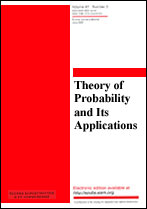|
This article is cited in 2 scientific papers (total in 2 papers)
A trajectorial approach to the gradient flow properties of Langevin–Smoluchowski diffusions
I. Karatzasa, W. Schachermayerb, B. Tschidererb
a Columbia University, New York, USA
b University of Vienna, Vienna, Austria
Abstract:
We revisit the variational characterization of conservative diffusion as
entropic gradient flow and provide for it a probabilistic interpretation
based on stochastic calculus. It was shown by Jordan, Kinderlehrer, and Otto
that, for diffusions of Langevin–Smoluchowski type, the Fokker–Planck
probability density flow maximizes the rate of relative entropy dissipation,
as measured by the distance traveled in the ambient space of probability
measures with finite second moments, in terms of the quadratic Wasserstein
metric. We obtain novel, stochastic-process versions of these features, valid
along almost every trajectory of the diffusive motion in the backwards
direction of time, using a very direct perturbation analysis. By averaging
our trajectorial results with respect to the underlying measure on path
space, we establish the maximal rate of entropy dissipation along the
Fokker–Planck flow and measure exactly the deviation from this maximum that
corresponds to any given perturbation. A bonus of our trajectorial
approach is that it derives the HWI inequality relating relative entropy (H),
Wasserstein distance (W), and relative Fisher information (I).
Keywords:
relative entropy, Wasserstein distance, Fisher information, optimal transport, gradient flow, diffusion processes, time reversal, functional inequalities.
Received: 19.05.2021
Accepted: 06.07.2021
Citation:
I. Karatzas, W. Schachermayer, B. Tschiderer, “A trajectorial approach to the gradient flow properties of Langevin–Smoluchowski diffusions”, Teor. Veroyatnost. i Primenen., 66:4 (2021), 839–888; Theory Probab. Appl., 66:4 (2022), 668–707
Linking options:
https://www.mathnet.ru/eng/tvp5505https://doi.org/10.4213/tvp5505 https://www.mathnet.ru/eng/tvp/v66/i4/p839
|


| Statistics & downloads: |
| Abstract page: | 243 | | Full-text PDF : | 67 | | References: | 44 | | First page: | 13 |
|




 Contact us:
Contact us: Terms of Use
Terms of Use
 Registration to the website
Registration to the website Logotypes
Logotypes








 Citation in format
Citation in format 
